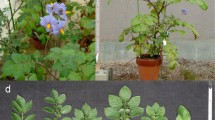Abstract
Neo-Tuberosum clones from the Cornell breeding population were evaluated as female parents in combination with Tuberosum for production from true seed. Field trials of hybrid seedling families were carried out in 1982 and 1983. Families were also grown in a hot greenhouse to measure combining abilities for tolerance to heat stress. General combining ability was highly significant for yield, vine and tuber characteristics, and heat tolerance. Several clones were identified which produced outstanding seedling families for yield, uniformity, and tuber appearance. Some individual crosses were equal to cultivars in yields, uniformity, and tuber appearance. Hybrids of Neo-Tuberosum and Tuberosum appear to be an excellent choice for potato production from true seed.
Resumen
Clones Neo-Tuberosum de poblaciones de mejoramiento de Cornell fueron evaluados como madres, en combinación con Tuberosum, para la producción de papa a través de semilla botánica. En 1982 y 1983, se llevaron a cabo ensayos de campo de familias de plántulas hibridas. También se cultivaron familias en un invernadero caliente para medir las capacidades combinadas para la tolerancia al estrés al calor. La capacidad general de combinación fue altamente significativa para el rendimiento, características del follaje y de los tubérculos, y la tolerancia al calor. Varios clones que produjeron sobresalientes familias de plántulas por su rendimiento, uniformidad, y apariencia de los tubérculos, fueron identificados. Algunas cruzas individuales fueron iguales a los cultivares en rendimiento, uniformidad, y apariencia de los tubérculos. Los híbridos de Neo-Tuberosum y Tuberosum parecen ser una alternativa excelente para producir papas a través de semilla botánica.
Similar content being viewed by others
Literature Cited
Ben Khedher, M., B.A. Kahn, E.E. Ewing, H.A. Mendoza and R.L. Plaisted. 1983. Traits useful in selecting for potato heat tolerance. Am Potato J 60:812 (abstr.).
Cubillos, A.G. and R.L. Plaisted. 1976. Heterosis for yield in hybrids betweenS. tuberosum ssp.tuberosum andtuberosum ssp.andigena. Am Potato J 53:143–150.
Ewing, R.E. 1981. Heat stress and the tuberization stimulus. Am Potato J 58:31–49.
Glendinning, D.R. 1969. The performance of progenies obtained by crossing groups Andigena and Tuberosum ofSolanum tuberosum. Eur Potato J 12:13–19.
Hoopes, R.W., R.L. Plaisted and A.G. Cubillos. 1980. Yield and fertility of reciprocalcross Tuberosum-andigena hybrids. Am Potato J 57:275–284.
Kidane-Mariam, H.M., H.A. Mendoza and R.O. Wissar. 1983. Combining ability study of tetraploid parental lines for yield and uniformity in true potato seed (TPS) families. Am Potato J 60:813 (abstr.).
Lazin, M.B. and E.E. Ewing. 1979. Influence of maternal parent on inheritance of critical photoperiod for potato tuberization. Hortscience 14:406 (abstr.).
Li, J.H. and J. Shen. 1979. Production of marketable and seed potatoes from botanical seed in the People’s Republic of China, p. 21–28In: Production of Potatoes from True Seed, Report of a Planning Conference, Manila, Philippines. International Potato Center. Lima, Peru.
Mullin, R. and F.I. Lauer. 1966. Breeding behavior of F1 and inbred potato clones. Proc Am Soc Hort Sci 89:449–455.
Plaisted, R.L. 1980. PotatoIn: W.R. Fehr and H.H. Hadley (eds.). Hybridization of Crop Plants. American Society of Agronomy-Crop Science Society of America, Madison, WI. pp. 483–494.
Plaisted, R.L., L. Sanford, W.T. Federer, A.E. Kehr and L.C. Peterson. 1962. Specific and general combining ability for yield in potatoes. Am Potato J 39:185–197.
Sanford, J.C. and R.E. Hanneman Jr. 1982. Large yield differences between reciprocal families ofSolanum tuberosum. Euphytica 31:1–12.
Tai, G.C.C. 1976. Estimation of general and specific combining abilities in potato. Can J Cytol Gen 18:463–470.
Tarn, T.R. and G.C.C. Tai. 1973. Heterosis in F1 hybrids between Group Andigena and Group Tuberosum potatoes. Am Potato J 50:337 (abstr.).
Tarn, T.R. and G.C.C. Tai. 1983. Tuberosum × Tuberosum and Tuberosum × Andigena potato hybrids: comparisons of families and parents, and breeding strategies for Andigena potatoes in long-day temperate environments. Theor Appl Genet 66:87–91.
Thompson, P.G. and H.A. Mendoza. 1984. Genetic variance estimates in a heterogenous potato population propagated from true seed (TPS). Am Potato J 61:697–702.
Author information
Authors and Affiliations
Additional information
Paper No. 827, Department of Vegetable Crops, Cornell University; from a Ph.D. thesis by the senior author. This research was supported by a contract between Cornell University and the International Potato Center of Lima, Peru.
Former graduate student, Department of Vegetable Crops, Cornell University
Rights and permissions
About this article
Cite this article
Rowell, A.B., Ewing, E.E. & Plaisted, R.L. General combining ability of Neo-Tuberosum for potato production from true seed. American Potato Journal 63, 141–153 (1986). https://doi.org/10.1007/BF02853538
Accepted:
Issue Date:
DOI: https://doi.org/10.1007/BF02853538



